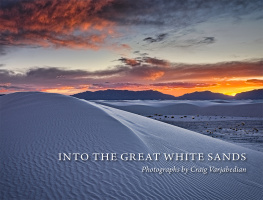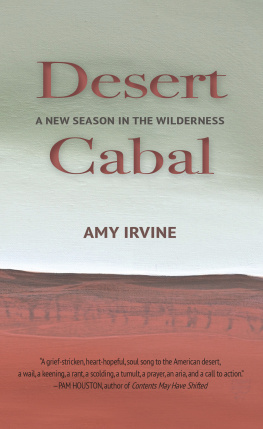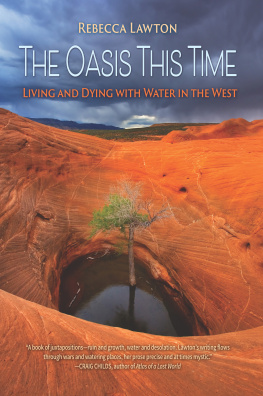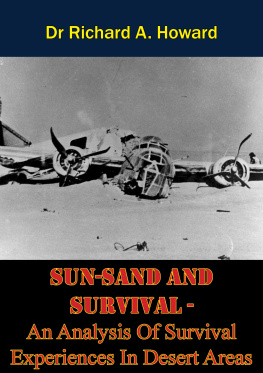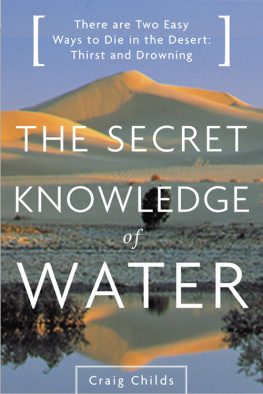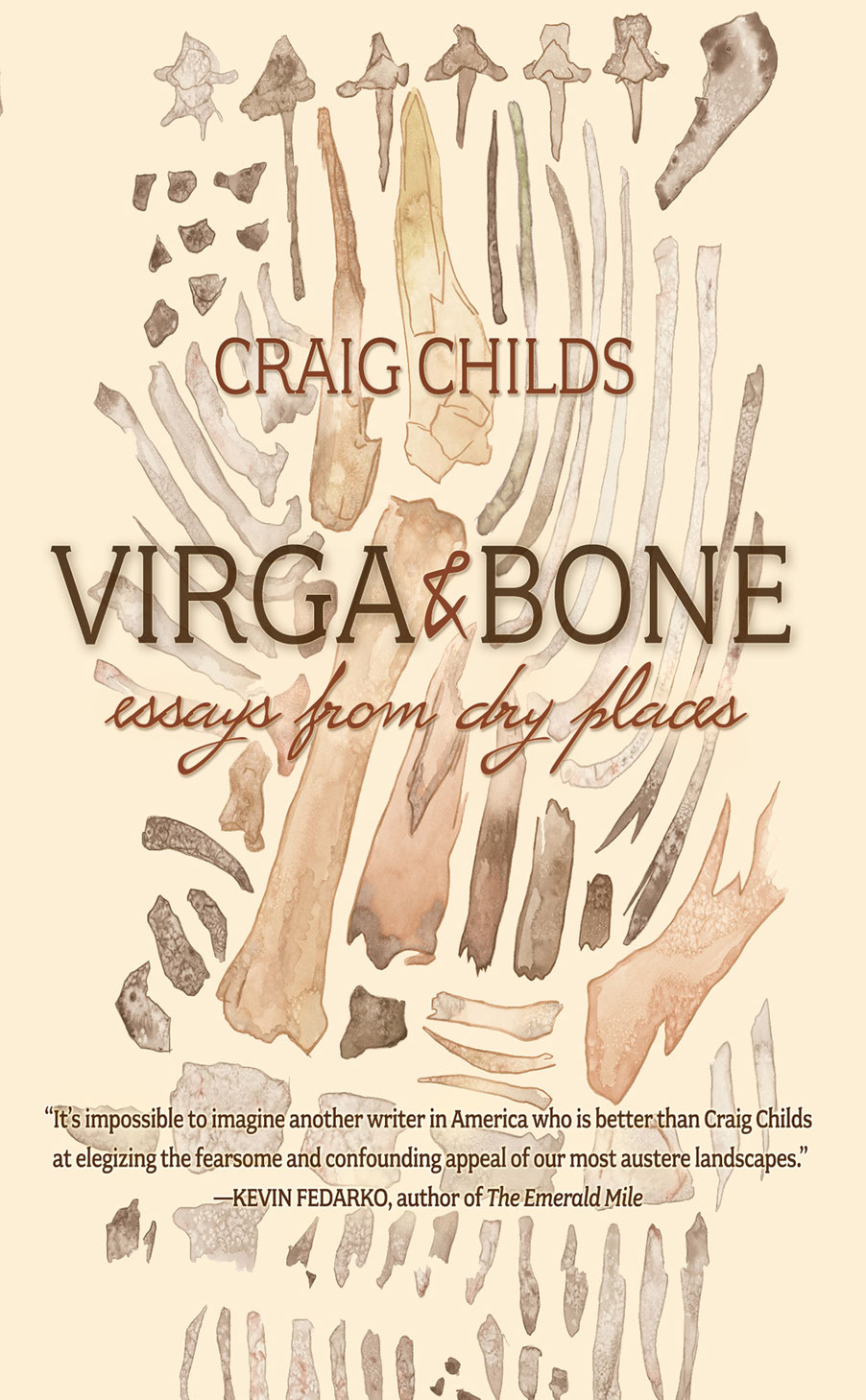Praise for Virga & Bone
Its like Childs was born out of pink sandstone, given a mouth to speak, and has continued to defend his mother ever since. Youll read this book in one night but youll reflect on it for a lifetime.
ANNE HOLMAN, The Kings English Bookshop
Love songs earned in a life lived close to the wild.
ALISON HAWTHORNE DEMING, author of Zoologies: On Animals & the Human Spirit
Craig Childs takes us not only through the external landscapes of the huge and wondrous; he takes us into and through himself.
MARY SOJOURNER, author of The Talker and 29
A desert koan, Childs latest is still and restive, full of unresolved pairings and brilliantly so. His 1,000-watt prose is as alive as the heat that makes the Mojave tick.
ELIZABETH RUSH, author of
Rising: Dispatches from the New American Shore
A tribute to the orphaned landscape of the borderlands.
GREG CHILD, author of Over the Edge
A bright hard gem of a book.
WILLIAM DEBUYS, author of A Great Aridness and The Last Unicorn
Childs is a master of bringing the outside inward.
M. JOHN FAYHEE, ex-editor of the Mountain Gazette and author of Smoke Signals and Bottoms Up
An arid, haunting feast.
REBECCA LAWTON, author of The Oasis This Time
Adorned with fierce, aridly gorgeous insights. KEVIN FEDARKO, author of The Emerald Mile
Childs shows us how to look in ways that we might find our own unique contribution to a future where all life thrives.
BROOKE WILLIAMS, author of Open Midnight
VIRGA & BONE
ALSO BY CRAIG CHILDS
Atlas of a Lost World
The Secret Knowledge of Water
Flying Home
Apocalyptic Planet
The Animal Dialogues
Finders Keepers
House of Rain
VIRGA & BONE
essays from dry places
CRAIG CHILDS
Illustrations by
Claire Taylor
First Torrey House Press Edition, October 2019
Copyright 2019 by Craig Childs
All rights reserved. No part of this book may be reproduced or retransmitted in any form or by any means without the written consent of the publisher.
Published by Torrey House Press
Salt Lake City,
Utah www.torreyhouse.org
International Standard Book Number: 978-1-948814-18-8
E-book ISBN: 978-1-948814-19-5
Library of Congress Control Number: 2019940780
Cover art Bones of an Unknown Beast by Claire Taylor
Interior art by Claire Taylor
Cover design by Kathleen Metcalf
Interior design by Rachel Davis
Distributed to the trade by Consortium Book Sales and Distribution
For the desert people, wash-walkers and followers of desolation
CONTENTS
vrg: n. rain that falls but evaporates before touching ground
bn: n. parts of the skeleton, what is left when everything else erodes
INTRODUCTION
To write this book, I holed up on a far side of Tucson at the edge of the desert. In one direction the night was lit up, the city droned on, and in the other stood dark mountains, saguaros rising into stars. My writing table was up against a rammed earth wall in a modest cave of a house, no extra bedroom, no doors inside, a cistern shower in the bathroom and a composter for a toilet. I stacked and laid books on the work table, poetry mostly, Bass, Neruda, Oliver, Hoagland. There were a few longer reads, reminding me of what I was doing here: Abbey, Meloy, Lopez, Irvine. A mix of the living and the dead.
The place was empty but for a couch, a refrigerator, a wooden kitchen table, and a chair that I salvaged from a dumpster in the city. My friend next door, down a faint trail through cactus, offered the place for me to work. My gal saw a picture I texted and said it looked like I was writing in a Turkish prison, bare earthen floors and walls. She didnt see the sliding glass door I left open most of the day, and the clouds of spring-green creosote bushes and big-padded prickly pear cactus growing to the edge of worn steps. These werent landscaping plants; theyd been growing here for centuries, swelling and shrinking with every rain and drought. Ribbed arms and heads of saguaros studded the skyline where Gila woodpeckers and curve-billed thrashers kept up conversation, and quail bobbed on the ground like sly, pear-sized hens. The Sonoran Desert in southern Arizona this time of year can be a circus. You have to get up sometimes and close the door to stay focused.
At night, my lamp on inside, pages rattled out of my keyboard. I looked up at a fox as it passed sleekly by, its nose almost touching the glass of the door slid closed. It glanced inside and trotted through creosote bushes where the dark of the desert took it back in.
A block away was the rest of Tucson, the desert crunched into lawns and landscape gravels. You could draw a line dividing here from there, light and darkness, mountains huddled back from the city and green from the rains and cool days of March, the other direction roofs.
I remember when I was a kid seeing road signs at the edge of Phoenix, after the last subdivisions, upon which people spray-painted SAVE OUR DESERT. Curve Ahead: SAVE OUR DESERT. Do Not Enter When Flooded: SAVE OUR DESERT. I hadnt put two and two together, I didnt know why the desert needed to be saved. Those places are gone now, stripped and replaced, little sense of what might have once been there. I dont know who did the graffiti in the 1970s, but when I was a kid, I imagined them dressed in bandanas, coming out of the desert, pushing against the city, defending forests of ironwood and saguaros, quail bursting into the air like little jets.
Driving back with groceries to the house where I was working, turning from pavement onto dirt, I stopped at a diamondback rattler half on and half off asphalt. It was drawing up warmth as the day ended, not a good idea with cars coming by. Did it know the dangers here, or was the snake not thinking car, tires, weight, death? I backed up until I could see along the length of its body from my rolled-down window. I told it to get off the road. It didnt. I opened the door, only got a head flinch, the snake laid out more or less straight, an arm and a half long with a mature stack of rattles at the end nearest me. Go, I said, waving my arms, and the rattler reluctantly moved. I got out and shooed it along as it picked up speed with a few half-hearted buzzes of its tail. As the head went into the base of a sprawling creosote, out of range of a strike, I took a notion to reach down and touch the rattle, let the thing buzz through my hand. How often does that happen? I could use a little snake medicine in this book, I thought. It was not something Id ever done, but seemed doable. Following the slip of the tail, two inches away from grazing my fingers, I said, out loud, No.
What rattlesnake wants its rattle touched?
NO MOLESTAR LA FAUNA reads the sign outside of a biosphere reserve in the desert of northern Mexico, a few hours from here. The phrase rolls off the tongue. Dont molest the animals. Dont pick up desert turtles or pet rattlesnakes. The flora, while were at it, needs no manhandling or groping, no more stately dead ironwoods stripped for campfires. We could save a planet obeying signs like these.



